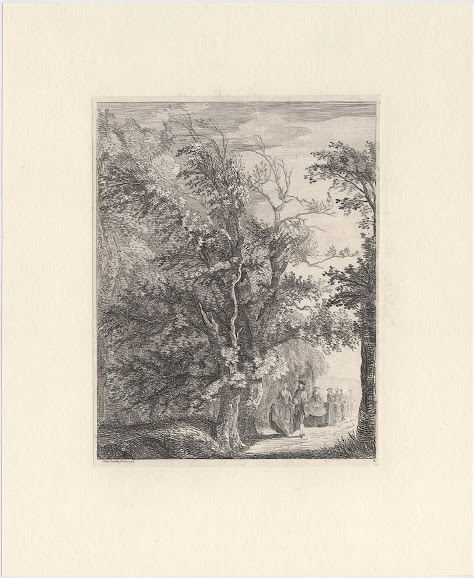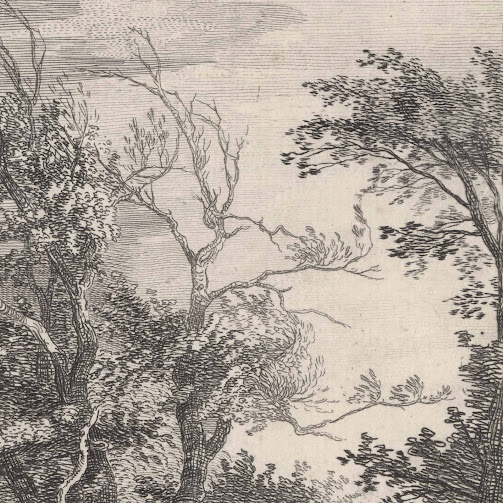Paul Sandby (1731–1809)
“In the Meadows near Edinburgh” (aka “The Meadows”; “The Promenade in the Park”), 1751, from the series, “Scottish Landscapes (second set, vertical), published in 1765 by Ryland and Bryer (fl.1765–1772) in a folio of one hundred of Sandby's etchings. “A Collection of Etchings” (see John Bonehill & Stephen Daniels [eds.] 2009, “Paul Sandby (1731–1809): Picturing Britain”, London, Royal Academy of Arts. p. 104).
Etching on buff (presumably laid) paper, trimmed close to the image borderline and backed with a support sheet to provide wider margins.
Size: (support sheet) 34.6 x 28.5 cm; (sheet) 22.3 x 17.4 cm; (image borderline) 21.5 x 16.9 cm.
Inscribed in plate outside the image borderline: (lower left) “Paul Sandby Fecit 1751”; lower right) “K”; (upper right [partly trimmed]) “4”.
Gunn 81 (Ann V Gunn 2016, “The Prints of Paul
Sandby (1731–1809): A Catalogue Raisonnae”, Turnhout, Harvey Miller, Brepols, p.
137, cat. no. 81).
Gunn (2016) advises "The figures of the strolling man and woman are from a drawing in the Royal collections (RL 14470, Oppé 1947, no 223). They appear here reversed” (see BM Curator’s comment: https://www.britishmuseum.org/collection/object/P_2019-7015-600).
The British Museum offers the following description
of this print: “View in the meadows in Edinburgh; a couple approaching along a
path bordered by thick trees on the left, with other ladies and gentlemen
further off on the path, which recedes into the sunlight, diagonally to right.
1751/ Etching” (https://www.britishmuseum.org/collection/object/P_1904-0819-500).
See also the description of this print (not illus.) offered by the Rijksmuseum: http://hdl.handle.net/10934/RM0001.COLLECT.169971.
Condition: a well-printed impression trimmed with a narrow margin around the image borderline (partly trimming the number “4” at upper right) and laid upon a support of archival (millennium quality) washi paper. The sheet is in an excellent condition for its considerable age with no tears, holes, folds, abrasions, significant stains or foxing.
I am selling this exceptionally rare etching that is one of Sandby’s earliest prints executed at the age of 20, for the total cost of AU$326 (currently US$244.01/EUR220.43/GBP185.77 at the time of this listing) including postage and handling to anywhere in the world (but not, of course, any import duties/taxes imposed by some countries).
If you are interested in purchasing this very
beautiful etching exemplifying Sandby's early interest in subtle tonal nuances
that he was later to advance with his celebrated explorations of aquatint,
please contact me (oz_jim@printsandprinciples.com) and I will send you a PayPal
invoice to make the payment easy.




















































